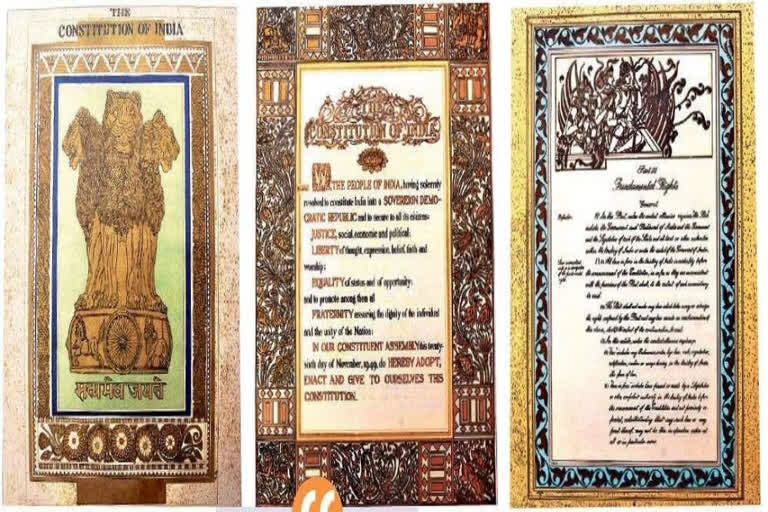Dehradun:The founding document of India--the Constitution of India, turns 70 on this Republic Day. The handwritten copy of the constitution of India has been preserved in the Survey of India in Dehradun, while the original copy of the handwritten constitution has been kept in the National Museum of New Delhi.
The Dehradun-based Survey of India which printed 1,000 initial photolithographic reproductions of the handcrafted Constitution has preserved one of those copies.
The Constitution of India has emerged out of the tide of time, struggle and motility. After implementing the world's largest written constitution, the biggest task was to print copies of the constitution, the task of which was entrusted to the Survey of India, which completed it in about 5 years, one copy of the batch of one thousand historical copies of the Constitution that was printed has been placed in the library of the Parliament, and another copy is still preserved in Dehradun.
The committee that drafted the Constitution of India wrote it by hand in Hindi and English which was later telegraphed. It did not include any typing and printing. The original copy of the Constitution of India was written by hand in the Survey of India in Dehradun itself. Prem Bihari Narayan, the resident of Delhi, wrote the constitution in italic style. Along with this, every page was decorated and decorated by artists of Shanti Niketan, after which every page of the Constitution was telegraphed and published through photolithographic technique in the Survey of India itself.
The complete saga of writing the Constitution Of India
We all know that we got independence on 15 August 1947, but we had no constitution to run the country. The Constitution was adopted by the Constituent Assembly of India on 26 November 1949 to form an independent republic and to make laws, and it was implemented on 26 January 1950.
The Constituent Assembly was established in the year 1946 to make the Constitution, which had 389 members. The first meeting of that assembly was held on 9 December 1946. In which the senior-most MP, Dr. Sachchidanand Sinha was elected as the Provisional President. After this, on 11 December 1946, Dr. Rajendra Prasad was elected the Permanent Chairman of the Constituent Assembly. After the partition of the country in the year 1947, the number of members in the Constituent Assembly was reduced to 299.
The structure of the constitution was adopted on 26 November 1949 after 2 years 11 months and 18 days of the establishment of the Constituent Assembly. After which the handwritten constitution was signed by 284 Members of Parliament of the Constituent Assembly on 24 January 1950.
On 26 January 1950, the Constitution of India was implemented. The constitution has 465 Articles and 12 Schedules divided into 22 parts, which has been amended more than 100 times so far.
After independence, the Drafting Committee under the chairmanship of Dr Bhimrao Ambedkar drafted it to prepare a written truss of the country's constitution. The world's largest written constitution was also accepted by the Constituent Assembly on 26 November 1949. There was also a challenge to publish it after that, as the Drafting Committee and especially the Indian leadership wanted to publish it with the same handmade decoration to preserve the originality, form and memory of this sacred book of Indian democracy.
